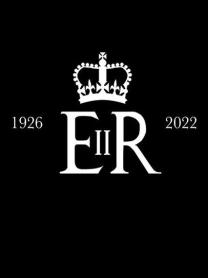
Queen Elizabeth II: Global Icon
Global Brand The puzzle at the centre of the British monarchy is how it remains so influential after losing most of its power over the last century.
Her Late Majesty ruled Great Britain, Northern Ireland, and a reduced list of other countries, yet had no executive role except within the Royal Household. Britain’s armed forces talk of fighting the enemies of the Queen/the King, but she/he may not send them into battle. The Commonwealth is the democratic remainder of Britain’s once- enormous empire. The Queen was Defender of the Faith, a role she took very seriously but, with her old powers removed and just 1% of the UK’s population still going to church, this was no longer a mighty alliance. She asked 15 different prime ministers to form “her” government, but the question was ceremonial. It was British voters who chose them, and the Queen was allowed only “to encourage, warn and be consulted”. She was almost uniquely impotent among heads of state.
This makes the response to her death all the more astonishing. For several days images of the Queen replaced all roadside advertising around Britain. Differences were temporarily forgotten and the country felt unified for the first time since Brexit. Elizabeth II defined what it is to be a Queen. She was the only one: die Königin, la Reine. And, while she was the centre of interest, the world also embraced the British brand as a whole. The Brandenburg Gate was bathed in the union jack, President Biden ordered American flags around the world to fly at half mast, a global audience of millions watched the funeral including 29 million in the UK: 11m in Germany, 8m in France, 6m in Italy, 11m in the USA, 12m following on TikTok.
Her Majesty Elizabeth II was the most popular British Royal and the most famous woman in the world - beyond anything the Kardashians, Oprah Winfrey, the Obamas could claim. How did her brand become a global icon?
Duty
My Canadian grandfather joined the Royal Montreal Regiment in 1914 and somehow survived the war. In fact the worst day of his life was long after the four years he spent in the mud of Flanders. It happened on 10 December 1936 when Edward VIII put love before his obligations and abdicated. The decision made his brother king and his ten year old niece, Elizabeth, heir to the throne. It was the first abdication ever by a British monarch. My grandfather saw it as a terrible dereliction of duty and never forgave him.
What duty? In one important sense the Queen had no doubt. Years before her coronation she declared to the British people and the wider “imperial family” that her whole life would be devoted to serving them. This came before motherhood, marriage, friendships, everything. The more difficult question was how to translate this promise into a strong, enduring monarchy. The context was changing fast and the old levers of influence were no longer available. Royalty was an anachronism for nations like India demanding independence, and for many British citizens who had less reverence for authority after two world wars. But history will record that her struggle to influence was successful. At her funeral the Archbishop of Canterbury predicted that her service will be remembered long after “those who cling to power” are forgotten. (There has been much speculation about who he had in mind).
Consistency
Like every strong brand, the monarchy under the late Queen was consistent over decades. And visible. Her coronation in 1953 was the first big event on British television, and families bought half a million TVs so they could watch it. Over the course of her reign she personally met an estimated 3 million individuals - from presidents to celebrities to ordinary people. She chose bright clothes to stand out in a crowd: “I have to be seen to be believed”, she said. Her colours could also be symbolic. Perhaps the most famous was the Irish green outfit she wore for her visit to the Republic of Ireland in 2011, the first by a British sovereign since the formation of Northern Ireland in 1921. To the practical discussions about the Good Friday peace agreement, the Queen’s personal diplomacy did much to add “a culture of reconciliation and partnership between these islands”, according to the Irish president. When in 2017 she gave a speech on behalf of her government about its Brexit plans, she wore a blue hat with yellow buttons, interpreted by many as solidarity with the EU. She made no comment, of course.
Her most remarkable achievement was to provide continuity during an era of seismic change, and we still don’t know what she thought about any of it. Under the (unwritten) constitution she could not make her opinions public because this might undermine her elected politicians. She also thought silence was an advantage because it helped the monarchy to retain some mystery - a difficult ambition given the insatiable media appetite for in- formation about royal celebrities. If HM the Queen did speak, it was with supreme tact. When Meghan claimed that a member of the Royal Household had made racist comments, the Queen said she would take the allegation seriously, adding simply: “recollections may vary”. Private conversations were different, and her longevity gave her a perspective which no leader of any other organisation or country could match. It meant that a young president of Dominica in the Caribbean could seek advice from someone who had known Nehru, the first prime minister of India.
„
Today we need a special kind of courage. Not the kind needed in battle, but a kind which makes us stand up for everything we know is right, the kind of courage that can withstand the subtle corruption of the cynics – so that we can show the world that we’re not afraid of the future.“
HM Queen Elizabeth II 1926–2022
The intangible
Queen Elizabeth could be ruthless. She did not hesitate to sack Prince Andrew over his sex scandal. In 2020 she forced Harry and Meghan to choose between independence and working full-time for the Royal Household. Without her permission they had announced a “new working model” which, they hoped, would allow them to exploit the royal brand from outside the Firm. Their original website (sussexroyal.com) sets out their naïve ambition and can still be seen. The House of Windsor (the family name which replaced Saxe-Coburg-Gotha in 1917) was quick to sanction any company displaying its logo. Dating back to the middle ages, the Royal Warrant says “this is where the Queen/King shops”. It’s like access to Manchester United but without the license fee. Warrant holders work hard to keep the right to use the logo because consumers around the world will pay a premium for it. Rigby & Peller was recently de-listed after publishing an indiscreet memoire about selling underwear to the Queen. It was a warning to 800 other warrant holders that the royal brand does not tolerate short-term marketing tactics like this. Now that Charles is king, the House of Windsor is likely to demand much higher environmental standards in return for a royal warrant.
The intangible
A 2017 assessment by Brand Finance calculated that the British monarchy is worth £68 billion, of which £42 billion are intangible benefits that accrue to the British economy. This includes £550 million from tourism, £150m from patronage eg the Royal Opera House, £150m from trade (70% of Chinese shoppers prefer to buy products with a royal warrant), £50m from media eg The Crown. But numbers alone do not explain the royal brand today. The first instinct of organisations is to control what is valuable and quantify as much as possible: not just the outcomes they desire but everything that might cause them. The Queen and her advisers used many of the tools that are familiar to good brands. Consistency over 70 years, though? That is rare, and the clue lies in what the House of Windsor could not control. The Queen understood above all that her role was contradictory - status without power - so she concentrated on something she could influence: to offer leadership through service. Perhaps, if she kept her promise, this fragile, unmeasurable idea could count for something.
Every brand promises the intangible, but the delivery of it is hard because organisations struggle to value concepts like values and purpose outside the language of targets and performance. The Queen’s commitment to serve was not an objective; it was her modus operandi. The final proof of its value came this September in the form of 16 km queues to see her coffin, tributes around the world from leaders who admired her, and people everywhere, republicans included, who saw something noble in her which they wanted to see in themselves also. It is the sort of respect every brand dreams of.








